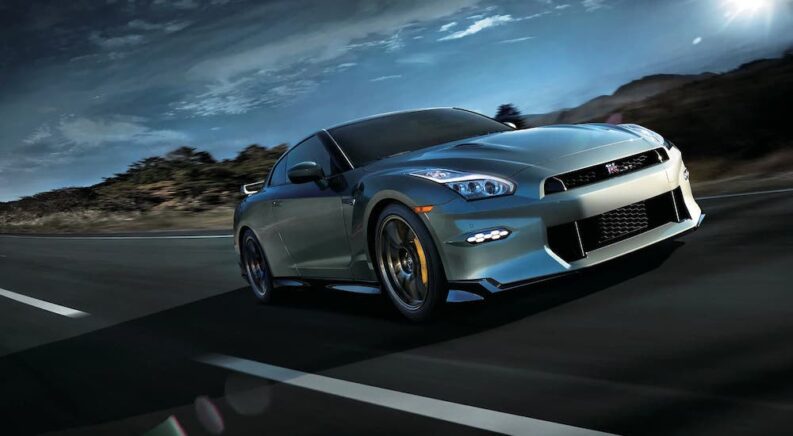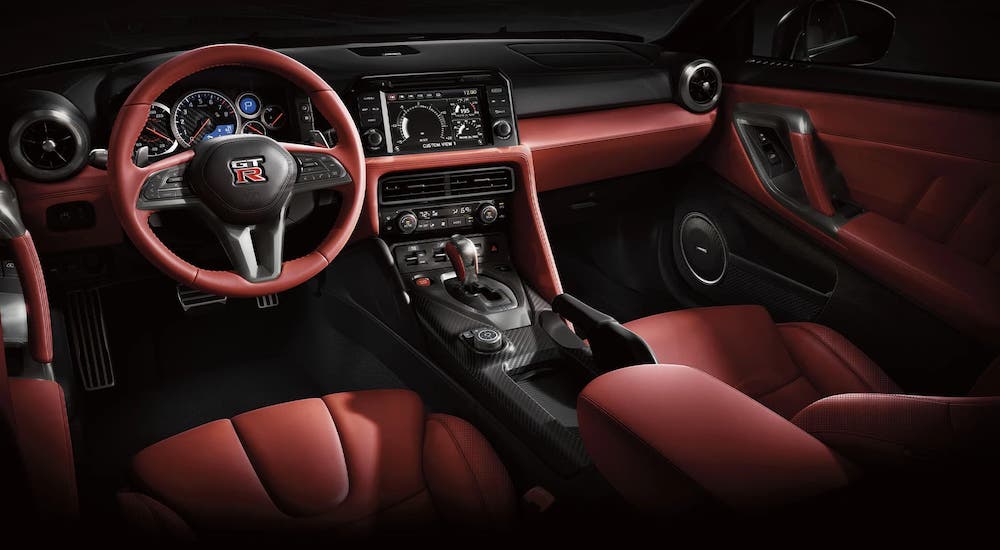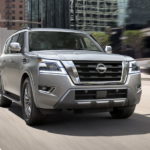With so many thrilling models in the lineup, a quick look around your local Nissan dealer is sure to turn up all sorts of enticing prospects. Nissan is a bit of an anomaly in the auto world, crafting not only some of the industry’s most affordable models but also making its presence known in the performance end of the market. From reliable, family-focused models like the Altima sedan and Rogue crossover to the powerful V8-powered Titan pickup and all-electric Leaf compact, the Nissan lineup truly runs the gamut, but picking Nissan’s most iconic car is no easy task.
Some drivers might gravitate towards the 350Z, which has become a favorite in the tuning world thanks to its clever combination of affordability and power. Able to keep pace with the Porsche 911 while ringing at less than half the cost, the 350Z also boasts legendary reliability, with some models reportedly eclipsing the 300,000-mile mark.
Nissan’s previous Z iterations — back in the brand’s Datsun days — also have a strong following, with models like the 240Z etching their place in automotive history. Widely cited as one of the most significant Japanese sports cars to hit the international market, the 240Z’s claim to fame was its ludicrous power-to-weight ratio that saw the 2,300-pound coupe produce some 151 hp.
Or maybe you’re a fan of the 90’s icon that was the 240SX. Available as a coupe, hatchback, or convertible, the 240SX proved that a four-cylinder model could be just as thrilling and fun to drive as some of its brawnier cousins. Nissan also threw in MacPherson struts and a rear multi-link suspension for good measure, significantly upping the sports compact’s handling capabilities. Those are all good suggestions, but in truth, the competition isn’t even close. With countless appearances in film, television, and video games — including a starring role in multiple Hollywood blockbusters — the Skyline GT-R is easily Nissan’s most iconic model.
The First Japanese Supercar
Commonly cited as Japan’s first supercar, the Skyline GT-R is the model that put Nissan on the map in the performance realm. The Skyline GT-R traces its lineage back to 1957 when Prince Motor Company — which would merge with Nissan in 1966 — produced the first GT Skyline, which was more of a four-door luxury sedan than the souped-up coupé we know today. The early version of the famous Skyline GT-R would take its name from the Japanese word sukarain or “Skyline,” which describes the type of mountain road the car was designed to dominate.
The 1969 Tokyo Motor Show would be the Skyline GT-R’s coming-out party, with Nissan introducing the 160-horsepower sedan to the world. That might not sound like supercar-level power by today’s standards, but given the era and the Skyline GT-R’s modest 2,400 lbs, the power-to-weight was tough to beat. Powered by a 2.0-liter inline-six engine, the original Skyline GT-R was also notable for its superb handling thanks to its four-wheel, semi-trailing arm strut independent suspension and limited slip differential. If there were any doubts about the Skyline GT-R’s performance credentials, all one had to do was take a quick look at the tires. Nissan opted for H-rated treads, giving the model all the rubber it needed to hit speeds of up to 130 mph.
To say that the Skyline GT-R was a hit right out of the gate would be an understatement. The fledgling supercar not only won the very first race it entered, it wouldn’t lose a single for multiple years and was only defeated in its 49th outing. The Skyline GT-R would notch 52 victories on the Japanese domestic touring circuit in its first three years, rocketing the sports car to considerable fame and announcing Nissan as a force to be reckoned with in the performance segment. The Skyline GT-R also earned a loyal following amongst Japanese drivers, who quickly bestowed the sports car with the nickname “Hakosuka”. Combining the Japanese word hako (“box”) with suka (“Skyline”), Hakosuka would be the Skyline GT-R’s first nickname, but certainly not its last.
Sadly, the Skyline GT-R’s popularity and brimming trophy case weren’t enough to save the sports car from the oil embargo of the 1970s. Big, thirsty sports and muscle cars were out, and economical compacts were in, with the second-generation Skyline GT-R booted out of the lineup in 1973. Drivers would have to wait 16 years for the Skyline to return in its R32 form.
The Legacy Continues
Debuting in 1989, the fourth-generation GT-R Skyline is known amongst Nissan fans as the R32 thanks to the model’s E-BNR32 chassis code. Sixteen years can bring a lot of change in the auto world, and the revived GT-R Skyline gave the Nissan team a great excuse to explore all the high-performance advancements of the last two decades. The R32 was powered by a 2.6-liter turbocharged inline-six engine with some 276 hp that allowed the coupé to reach 60 mph in just 5.6 seconds, but it was the model’s unique all-wheel drive system that really set it apart on the track.
Nissan developed a proprietary motorsport-oriented AWD system called Advanced Total Traction Engineering System for All-Terrain (ATTESA) for the R32, giving the performance car unrivaled traction. The R32 was unlike any car to emerge from Japan, dominating the racing circuit and humbling established winners like the E30 BMW M3 Evolution in the process.
This dominance — along with the GT-R Skyline’s Japanese heritage — earned the R32 a second, equally memorable nickname that has stuck to this day: Godzilla. Named after the silver screen’s towering “King of the Monsters,” the Godzilla would go on to terrorize the motorsport world with its raw pace and set a new record for a production vehicle at the legendary Nürburgring Nordschleife track.
The fourth-gen GT-R Skyline, dubbed R33, would go on sale in 1995 and represent one of the less dramatic generational changes. Powered by a similar engine, turbocharger, and gearbox, the R33’s most notable upgrade would have to be a new version of ATTESA known as ATTESA E-TS PRO, which added an Electronic Torque Split (E-TS) feature to the system. Nissan also stiffened the R33’s body and weight distribution for a more stable, responsive ride, smoothing out some of the kinks from the previous generation and bringing the GT-R Skyline that much closer to supercar perfection.
Ready For Its Close-Up
Then there’s the R34. If there’s a most iconic version of an iconic Nissan vehicle, it would have to be the fifth-generation model, which launched in 1999 to rave reviews and no small amount of press. The R34 had the familiar 2.6-liter engine under the hood but gained a turbocharger for a twin setup that allowed the coupé to churn out 276 hp… if you believe the factory. It’s one of the auto world’s worst-kept secrets, but there was a gentlemen’s agreement between Japanese automakers that said no company would produce a vehicle with more than 276 hp, at least on paper.
In truth, automakers were breaking this rule all the time, with the R34 standing as one of the best examples of that common transgression. Independent estimates pegged the R34’s power at closer to 330 hp, and the performance vehicle could easily achieve 400 horses with a simple engine remap. That number has been pushed all the way up to 1,000 hp with the help of plenty of aftermarket parts, making the R34 a sneaky powerhouse despite its modest “official” stats.
The R34 had some other thoroughly modern tricks up its sleeve as well. Mindful of the GT-R Skyline’s popularity in the racing scene, Nissan gave drivers a 5.8-inch LCD multifunction display that allowed them to track all the pertinent performance stats, from turbocharger pressure to oil and water temperature and more. Later, limited-edition models like the GT-R V·Spec added even more functions to the mix, including intake and exhaust gas temperatures, and a Nismo Multi-Function Display offered a lap time, G-force meter, and improved boost pressure gauge.
No mention of the GT-R Skyline would be complete without touching on its considerable pop-cultural impact, particularly the R34 model. The supercar is immediately recognizable to any blockbuster-loving American as the hero car from 2002’s “Fast And Furious.” Driven by protagonist Brian O’Conner (Paul Walker), the 2002 Nissan Skyline GT-R R34 is used to defeat Dominic Toretto (Vin Diesel) and smuggle contraband before dying in a very Hollywood explosion. The GT-R Skyline and its descendant, the Nissan GT-R, would go on to become recurring stars in the Fast franchise, with various models appearing in almost all of the franchise’s films.
Another notable appearance is the 1999 Nissan Skyline GT-R R34 from 2003’s “2 Fast 2 Furious”, which might actually not be a GT-R at all. O’Conner purchases the Skyline at an auto auction but, in a later montage, is seen affixing a “GT-R” badge to the front grill. We’re not saying Mr. O’Conner was doing a little badge forgery, but it’s certainly suspect. Regardless of what was actually under the hood, he must have been working with something a little spicier than the stock Skyline if the film’s automotive antics — which include a gravity-defying bridge jump — are to be believed.
The R34 became an instant icon after its starring role in the first Fast film, rocketing in popularity — and price — as every driver tried to get their hands on the V6 starlet. The most stunning example would have to be the original 2000 Nissan Skyline R-34 GT-R featured in “Fast and Furious 4” — and later owned by Walker himself — which sold at auction for $1.3 million in 2023.
The Skyline is also no stranger to the small screen. The supercar has been a mainstay in auto racing video games since the late 90s, with countless appearances in popular series like Project Gotham Racing, Gran Turismo, Midnight Club, Forza, Need For Speed, and even Grand Theft Auto: San Andreas as the knock-off Elegy R32-spec. The car’s video game connection was also the jumping-off point for the GT-R Skyline’s most recent star turn as the face of the new “Gran Turismo” film starring David Harbour, Orlando Bloom, and Archie Madekwe, though technically it’s a R35 GT-R Nismo GT3, not a true Skyline.
Nissan would separate the two brands at the end of the R34’s production run in 2002, replacing it with the standalone GT-R in 2007. The Nissan GT-R would do the Skyline name proud with its dual-clutch 6-speed transmission, all-wheel drive, and 3.8-liter V6 twin-turbo engine producing 545 hp, and was also the most accessible version to date. Prior GT-R Skylines has been banned for import thanks to the Imported Vehicle Safety Compliance Act of 1988, which dictates that only vehicles 25 years or older could be sold in the US Previous US-based GT-R Skyline owners had to wait for this 25-year grace period to pass before getting their hands on the model. The GT-R bypassed this restriction, making the Japanese supercar available to Americans without the decades-long wait.
A True Legend
There’s no doubting the Nissan GT-R Skyline’s resume. The GT-R’s appearance in the new “Gran Turismo” movie and the GT-R Skyline’s untold cameos game appearances will help maintain its legend for years to come, but the car is more than just a pop culture touchstone. As the first true supercar to emerge from Japan, the GT-R Skyline would have already been a notable model, but its unparalleled performance, racing pedigree, and off-track celebrity have rocketed the coupé into the rarefied air of automotive legend.
Nissan might be more known for its lineup of practical, reliable daily drivers, but models like the GT-R Skyline and its descendant in the Nissan GT-R are living proof that the Japanese brand is no stranger to the high-performance arena. GT-R Skyline models are still exceedingly rare thanks to their limited import and Hollywood-driven popularity, but if you ever get to pilot one of these iconic Nissan performance cars through the Hub City, count yourself lucky.






